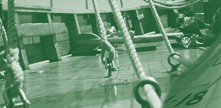| The history of S/Y Mohawk II
S/Y Mohawk II is Sjøkorpset’s
great pride. She was built in 1904 at the wharf Stowe & Son,
located in Shoreham at the southern tip of England. S/Y Mohawk II
is 92 feet long and carries up to 300 m2 of sail on her two masts.
She was bought by Sjøkorpset in 1952, and has brought tremendous
joy to the organization’s members ever since. She fulfills
the organization’s purpose perfectly: sail training for youngsters.
28.07.04 av Glenn Ivar Klausen (translated
by 229 Nina Schjoldager)
S/Y Mohawk II was launched in March 1904. Her name
was S/Y Sylvia at the time, and her original purpose was pure leisure
for a rich Englishman. The reason for naming the ship Sylvia is
unknown to us. In fact, we know very little about the ship’s
history from the day she was launched and until she was bought by
Sjøkorpset in 1952.
The ship was originally a gaff rigged yawl, and she could carry
about 350 m2 of sail. The information regarding this original rig
is scarce.
Neither do we have any original drawings, as the
wharf where she was built was bombed during the Second World War
and all archives were destroyed. Attempts have been made to locate
previous owners, hoping to attain original drawings. These attempts
have not succeeded.
Subsequently, the rig was changed, and when she was assigned to
Sjøkorpset, she was Bermuda rigged with a square-sail (pictured).
The mast had been shortened, and was considerably
shorter than the original one.
The ship had been built without an engine, but in about 1912 a 25
hp gasoline engine was installed with belt drive to the shaft. As
the ship was built without an engine, it was considered to be too
expensive to install the propeller mid ships. That is why the shaft
comes out on the port side, about 1 meter from the rudder.
This has caused difficulties when maneuvering in
narrow ports (greater difficulties than what is normal for long
keeled ships).
Mohawk was originally built with a lead keel, but during the Second
World War lead was confiscated to be used for producing ammunition.
The lead keel was at that time replaced with a iron keel and ballast.
The ballast consists of lumps made of iron and lead, weighing about
12 tons in all.
The ship was brought to Norway in 1953 - a legendary
adventure. The crew was surprised by a storm in a ship they hardly
know, but the situation was masterly handled.
The crew (pictured) was greeted as heroes when they arrived in Oslo
September 23rd 1953. The crew that brought Mohawk from England to
Norway consisted of the following people: Kåre Høybakk,
Arvid Larson, Thorleif Allum, Per Kristiansen, Bjørn Pedersen,
Harry Carstensen, Egil Spangen and Bjørn Millestad.
The original interior is almost intact beneath the deck. The exceptions
are the fore cabin and the galley. Sjøkorpset has made great
attempts to maintain as much as possible of the original woodworks,
and to recreate forgotten details in the interior design. Inscriptions
etc. found on old wooden pieces have been transferred when such
pieces have been replaced.
The ship has been subject to great repairs, and she has been restored
considerably since she was assigned to Sjøkorpset. The entire
deck was and the stern were replaced completely in 1986. The original
deck was made of Oregon pine, and this material was also chosen
for the new deck. The ship was built of teak on an oak frame, and
with the wooden floor made of teak. Oak has been the chosen material
for all recent replacements.
The current rig is base don drawings made in the 1950ies, and these
drawings have been followed when rigging the ship. The main mast
broke during s sail to Skagen in 1965. That mast was made of solid
wood. The new mast was made of laminated wood, and it was made shorter
than the previous one. The mizzen mast broke in 1977, and a new
laminated mast was made at Børsholmen.
In 1990 the running back-stay were moved to give a greater pull
and angle on the wire and a new rig was drawn to include a jib at
the front stay, to make it possible to fly a larger jib. This would
improve the speed when sailing in light winds.
Over the past few years we have been planning and preparing to purchase
a new engine. The current engine is a 67 hp Mercedes Benz from 1967.
The power is transferred via hydraulics, and the power strain on
the shaft is about 50 hp. The engine is a good old fellow that has
completed his mission in life. Nevertheless, the engine has been
very reliable despite its old age.
To the top
|





